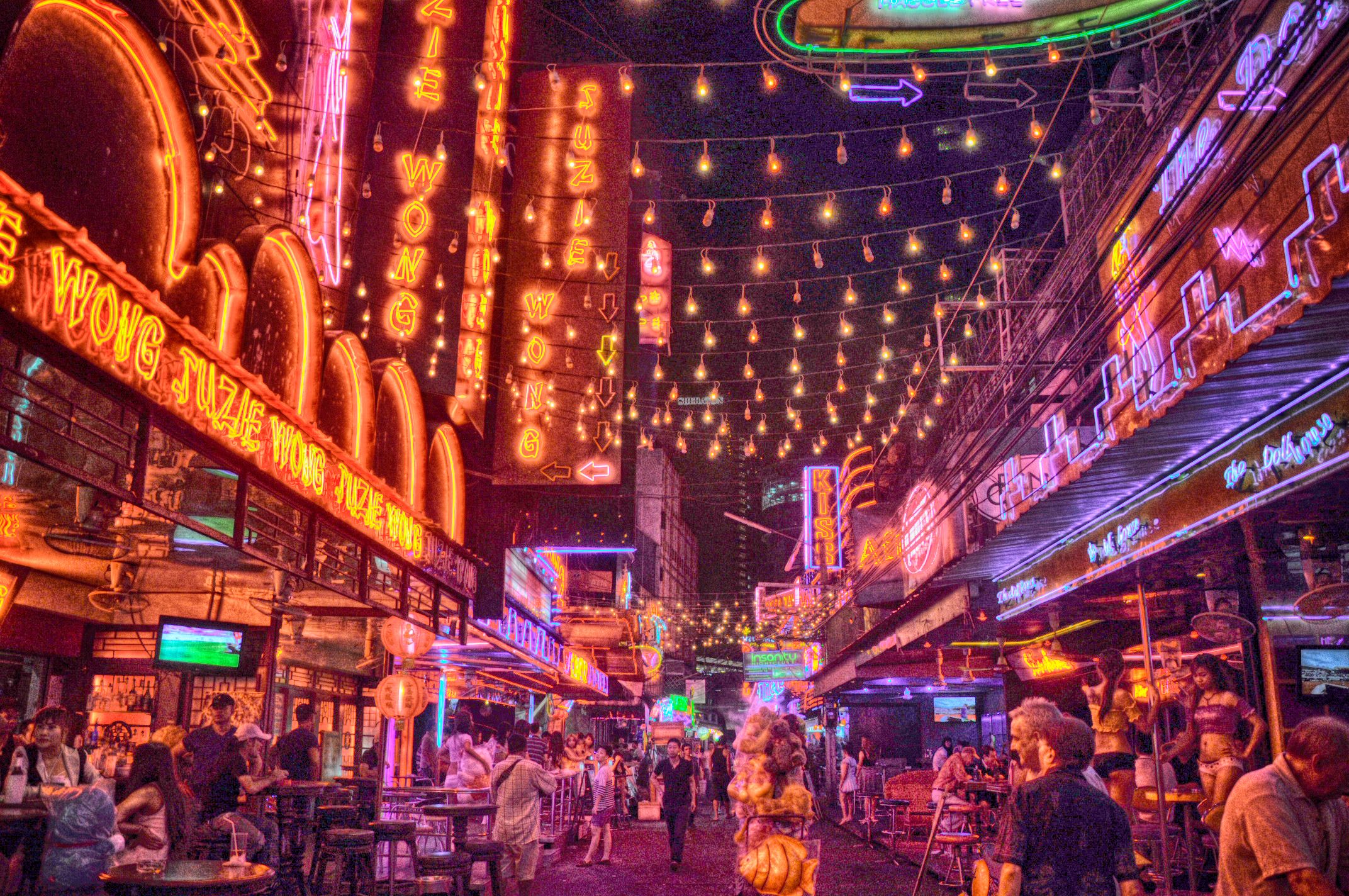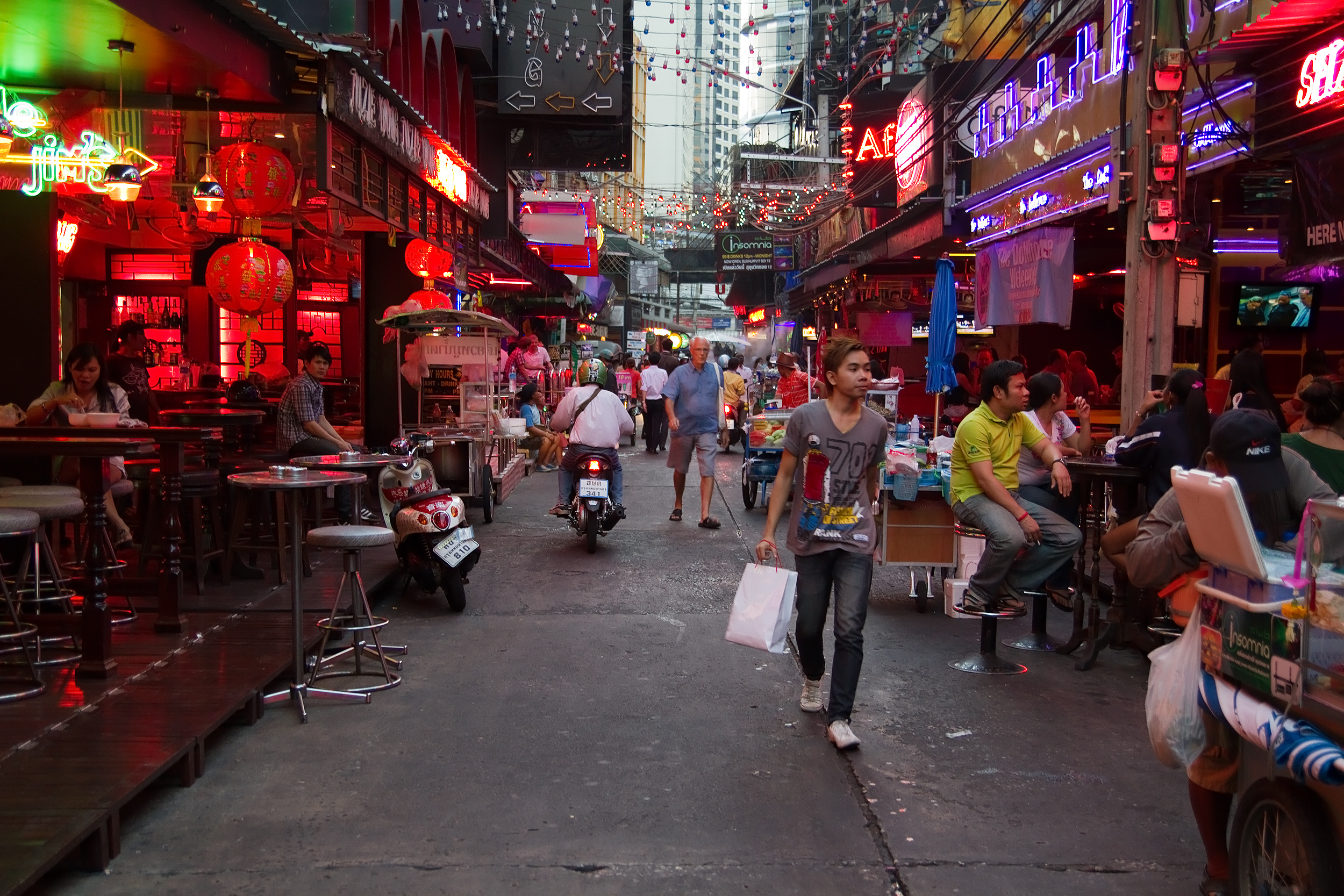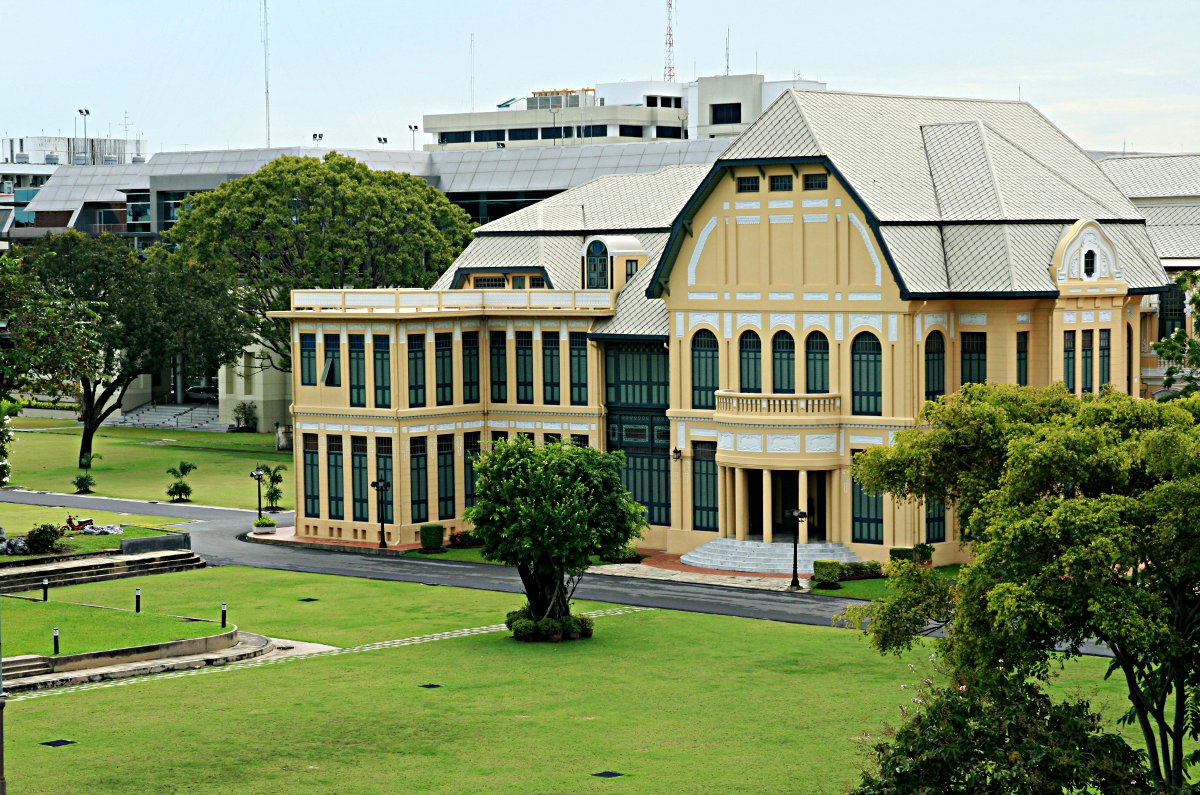The Vietnam War (1955–1975) was the “first television war” and as such played an important role in forming American public’s opinion on the US involvement in Vietnam. It resulted into three million people killed, widely spread posttraumatic stress disorders on both sides, but also into the boom of prostitution (particularly in Thailand) which was given by the weeks of “Rest and Recreation” of every deployed US soldier, spent outside of Vietnam. Twenty years after the war, three-quarters of Thailand’s tourists still consists of white single male sex tourists. And another twenty years later (in 2015), the sex industry generates 10 per cent of Thailand’s GDP. But how did we get here?
The Vietnam War (1955-75) was one of the most disruptive and divisive conflicts of the 20th century fought between communist North Vietnam and anti-communist South. The US engagement in this war was an example of direct application of the Containment Policy with the aim to stop the expansion of communism. It was based on the Truman doctrine, an American foreign policy announced by President Harry S. Truman in 1947.
In this case, it meant the support of the non-communist government in South Vietnam against the communist North Vietnam and the Viet Cong. (Lewis, 2019) Due to its media coverage, the Vietnam War is referred to as the “first television war” and as such, it also played a big role in forming American public’s opinion on the US involvement in Vietnam and influenced its support of it. Also, with growing American casualties also grew the public pressure against the war. (Spector, 2016)
In 1973, the US finally agreed to withdraw their forces. In 1975 Vietnam was unified into one single communist country called the Socialist Republic of Vietnam. Even though the US were de facto defeated, their opposition to the internationalization of communism did not end. (Lewis, 2019)
Since the beginning, even some of the American policymakers were sceptical about the potential of US victory in this war. Their worries have shown to be right in the end. The Vietnam War brought many atrocities, from the troop deaths on both sides and the deaths of Vietnamese civilians (who represented more than half of the dead, resulting in more than three million killed in total), to the psychological effects such as posttraumatic stress disorder and other post-war psychological problems among veterans, and environmental and health problems related to the use of herbicide and defoliant Agent Orange, and so forth. (Lewis, 2019)
This article mainly focuses on one other major impact of the war, being the boom of prostitution in Thailand, which emerged as a result of the presence of large troops of US armed forces in the region during the war.
Demand for entertainment business outside of Vietnam
The military presence of the US in Thailand started with the creation of US airbases in 1961 for the needs of the US Air Force during the Vietnam War. Likewise, each US soldier was eligible for one week of “R&R” (“Rest and Recreation, Recuperation or Relaxation”) and the most popular R&R destinations were Bangkok, Hawaii, Hong Kong, Kuala Lumpur, Penang, Manila, Seoul, Singapore, Taipei and Tokyo.
The R&R stations for the US military personnel were based on agreements between the US and chosen Asian governments according to the country’s proximity, social stability and friendly political alignment. (Suntikul, 2013)
Because of the harsh nature of combat, implying the way the soldiers spent their time off, the R&R was also known among the military as “I&I” (“Intoxication and Intercourse”). Thailand was also a place where at the peak of hostilities in 1969 were based more American soldiers than in Vietnam and where US airstrikes on Vietnam had taken place. (Suntikul, 2013) Between 1966 and 1969 around 70 thousand US soldiers visited R&R destinations in Thailand. Such concentration had created a demand for the entertainment business, including sex business. (Ralston, 1998)
The sex industry and the growth of red-light districts were supported by the Thai government for it contributed to the national economy. Even though brothels became illegal in 1960, prostitution as such did not vanish. The sexual services simply changed their venues. In 1966 the Entertainment Places Act was declared – since then, prostitution has also accompanied other recreation businesses such as bars, nightclubs, massage parlours, etc. (Suntikul, 2013)

The numbers of prostitutes in Thailand twentyfold
Obviously, prostitution as such did not emerge all of a sudden with the US military arrival, on the contrary, it is an ancient phenomenon (Truong, 1983). Even in the late 17th century, the Thai king was holding a monopoly on the provision from this kind of business. Up to 1950s around 20 thousands of prostitutes (mainly of Chinese origin) worked in Thailand, however, their numbers drastically increased (twentyfold to 400 thousand prostitutes in Thailand with 300 thousand only in Bangkok) and prostitution became visible with the US military presence related to their R&R holidays.
Nevertheless, prostitution served to Thais and non-Thais was separated and of a different character. Non-Thais men were oriented on venues where sexual services accompanied businesses such as bars, nightclubs and massage parlours, as was stated in 1966 Entertainment Places Act. (Suntikul, 2013)
The demand for prostitution met the supply of women migrating from rural areas to the urban cities searching more lucrative employments. Later, another wave of new prostitutes consisted of unemployed Thai women who were affected by the crop price crisis such as rice in the 1980s. (Brodeur at al., 2018)
In the 1970s more than half of the tourists travelled to Thailand for the sex entertainment (Suntikul, 2013) and after the Vietnam War ended, a campaign targeted on men from the West to travel to Thailand and sustain the sex industry has emerged. Considering a fact, that a 1995 study showed that almost three-quarters of tourists were white single men, we could say it was successful. (Woan, 2008)

The largest supplier of commercial sexual service
It is important to understand that previously described events had shaped the future patterns of tourism in Thailand, a country now known across the world for being the largest supplier of commercial sexual service. (Brodeur at al., 2018) Even though the sex work in Thailand is now criminalized, the law is being ignored.
The analysis of the spatial distribution of the Thai sex industry done by Brodeur et al. (2018) shows that till these days there is five times more commercial sex workers in districts located near former US military bases. In 2015, the sex industry generated about $6.4 billion (10 per cent of Thailand’s GDP) (NSWP, 2017) and in 2018 the estimated number of sex workers was 145 thousand. (Avert, 2020)
Given the conditions that mass tourism in Thailand confronted the institutionalized prostitution inherited from the US military presence, thus transforming prostitution of this volume into a significant element of international trade (Truong, 1983), there have automatically arisen many challenging consequences which Thailand has to (or should) deal with. One of them is the spread of sexually transmitted diseases, specifically the outbreak of the HIV epidemic due to the concentration of sex workers, which occurred in 1988. (Brodeur et al, 2018).
Good news is that HIV prevalence has sharply declined due to prevention programmes and the Thai government which reacted with targeted programmes encouraging the use of condoms in commercial sex. Probably as a result of the HIV epidemic and massive publicity campaign, since 1990, an abrupt decline in the number of prostitutes occurred. (Hanenberg and Rojanapithayakorn, 2010)
In 2018, HIV prevalence among sex workers in the country was less than five per cent, however, prevalence was much higher (reaching up to 20 per cent) among female sex workers in Bangkok. (Avert, 2020)

Possible solution?
One could argue that prostitution is inherently an act of exploitation which should be suppressed. However, it is crucial to acknowledge it as a very complex topic in which one should avoid making biased rushed decisions unaware of the specific context. As many feminist, human rights and other organizations concerned about sex workers argue, sex work is work and as such should be recognized and decriminalized, because “criminalizing sex work has not only failed to protect women from exploitation, it has also spectacularly failed to ‘end prostitution’ in Thailand or anywhere ever.“ (NSWP, 2016)
Therefore, rather than banning prostitution, the focus should be on supporting sex workers’ rights, improving their working conditions and quality of life. Most importantly the well-being of society should be the main government’s concern. (NSWP, 2016). Thus, in other words, we should focus on solving the main problems for which sex workers are deciding to go into this business (e.g. poverty, lack of other options and opportunities), rather than criminalizing their consequences.
One of the legacies of the Vietnam War and specifically of the presence of US military in Thailand is the service infrastructure for sex industry that has been maintained and reoriented for the post-war environment and modern globalized society. Because of the economic significance and embeddedness of prostitution Thailand has been struggling to redefine itself as a more diverse destination.
What’s next for tourism in Thailand
Although Thailand has the most successful tourism industry in the region (Suntikul, 2013), it still wrestles with many challenges emerging from the sex industry, such as unsafe working conditions for sex workers, sex trafficking, sexual exploitation (UNDP, 2012), or child prostitution, trafficking and exploitation. (ECPAT, 2016)
Since 1971, when the World Bank advocated and suggested to the Thai government to focus on the entertainment industry and tourism for fostering economic growth (Brodeur et al, 2018), Thailand has probably found itself in a difficult position, considering the mutually reinforcing relationship of mass commercial tourism and sex tourism.
It is therefore vitally important to consider all these challenges and many more, both directly and indirectly connected to them, and analyse their context and reason of existence in greater detail to be able to achieve a sustainable tourism future which is safe for all, tourists and workers.
Sources
Avert (2020). HIV and AIDS in Thailand. Available at: https://www.avert.org/professionals/hiv-around-world/asia-pacific/thailand, (Accessed: 25 March 2020).
Brodeur, A., Lekfuangfu, W. and Zylberberg, Y. (2018). War, Migration and the Origins of the Thai Sex Industry, Journal of the European Economic Association, 16(5), pp. 1540–1576. Available at: https://academic.oup.com/jeea/article-abstract/16/5/1540/4609693, (Accessed: 28 March 2020)
ECPAT (2015). Situational Analysis of the Commercial Sexual Exploitation of Children in Thailand: desk review. Available at: https://www.ecpat.org/wp-content/uploads/2016/04/SITAN_THAILAND_ENG_FINAL.pdf, (Accessed: 28 March 2020).
Hanenberg, R., Rojanapithayakorn, W. (2010). Changes in prostitution and the AIDS epidemic in Thailand, AIDS Care: Psychological and Sociomedical Aspects of AIDS/HIV, 10(1), pp. 69-79. Available at: https://www.tandfonline.com/doi/abs/10.1080/713612352, (Accessed: 28 March 2020).
Lewis, T. T. (2019). Vietnam War. Salem Press Encyclopedia, 6p. Accession number: 89111074, (Accessed: 26 March 2020).
NSWP (2016). Moving Toward Decent Sex Work. Available at: http://un-act.org/wp-content/uploads/2017/01/Moving_Toward_Decent_Work_EMPOWER.pdf, (Accessed: 28 March 2020)
NSWP (2017). Sex Work as Work. Available at: https://www.nswp.org/sites/nswp.org/files/policy_brief_sex_work_as_work_nswp_-_2017.pdf, (Accessed: 28 March 2020).
Ralston, J. (1998). Geishas, gays and grunts: What the exploitation of Asian pacific women reveals about military culture and the legal ban on lesbian, gay and bisexual service members. Law and Inequality: Journal of Theory and Practice, 16(2), pp. 661-712. Available at: https://pdfs.semanticscholar.org/5557/d7fc7ef7144076636747de818ce4c4d6d094.pdf, (Accessed: 27 March 2020).
Spector, R. (2016). The Vietnam War and the media. Available at: https://www.britannica.com/topic/The-Vietnam-War-and-the-media-2051426, (Accessed: 25 March 2020).
Suntikul, W. (2013). ‘Thai Tourism and the Legacy of the Vietnam War’, in Butler, R., Suntikul, W., (eds.). Tourism and War. Milton Park, Abingdon, Oxon: Routledge, pp. 92-105.
Truong, T. (1983). ‘The dynamics of sex tourism: the case of Southeast Asia’, Development and Change, (14), pp. 533-553. Available at: https://www.researchgate.net/profile/Thanh_Dam_Truong/publication/229628454_The_Dynamics_of_Sex_Tourism_The_Case_of_Southeast_Asia/links/5ac07e8aaca27222c759c40d/The-Dynamics-of-Sex-Tourism-The-Case-of-Southeast-Asia.pdf, (Accessed: 26 March 2020).
UNDP (2012). Sex Work and the Law in Asia and the Pacific: Laws, HIV, and human rights in the context of sex work. Available at: https://www.undp.org/content/dam/undp/library/hivaids/English/HIV-2012-SexWorkAndLaw.pdf, (Accessed: 27 March 2020).
Woan, S. (2008) ‘White Sexual Imperialism: A Theory of Asian Feminist Jurisprudence’, Washington & Lee Journal of Civil Rights & Social Justice, (14), pp. 275-301. Available at: https://scholarlycommons.law.wlu.edu/cgi/viewcontent.cgi?article=1243&context=crsj, (Accessed: 27 March 2020).
Poznámka: článek byl vytvořený v rámci předmětu Rozvojové příležitosti jižní a jihovýchodní Asie na Katedře rozvojových a environmentálních studií PřF UP v Olomouci (pod dohledem Dr. S. Šafaříkové a Dr. B. Markovič Baluchové)





